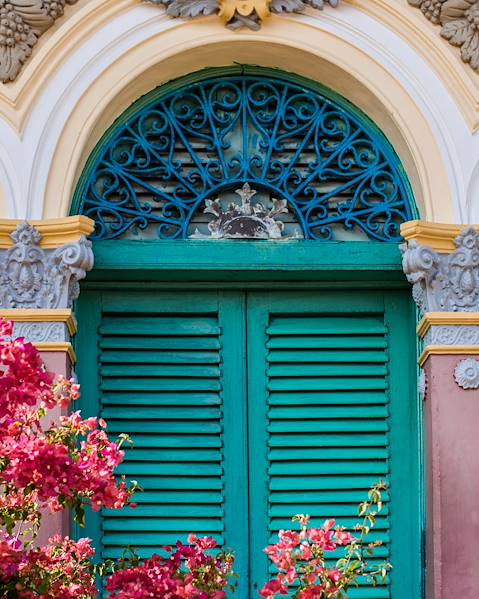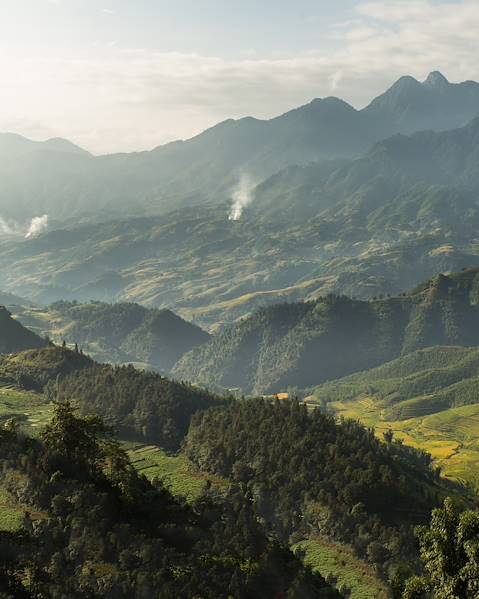Population
96,208,984 (2019).
Official language
Vietnamese if the official language. The Vietnamese written word, in its current form, was devised by missionaries in the 17th century who Romanised it and it is now written with the Latin alphabet. Until then, Chinese characters were used.
Language spoken
Although the vast majority of Vietnam’s population speak Vietnamese, there are over 100 recognised dialects and languages also spoken. In addition, several foreign languages ??are commonly used, with English and French the most widely spoken.
People
Vietnam has one of the youngest populations in the world. The Viet (or Kinh) make up the majority of the population at 85%. The largest minorities are Khmer, Han Chinese, Thai, Chinese Nung and Hmong. There are a total of 54 ethnic groups recognised by the Vietnamese government.
Religion
The most widespread religions are Buddhism, Confucianism, Taoism, Catholicism and Cao Dai. Ancestor worship is one of the oldest religious practices in Vietnam and most Vietnamese have an alter to remember the dead regardless of their religion. Buddhism is the leading religion of the country, with 55% identifying as Buddhist. Confucianism and Taoism denote an ancient and profound Chinese influence. The first Portuguese missionaries arrived in Vietnam in the sixteenth century and today Catholics represent about 7% of the population. Cao Dai is a comparatively new religion (it formed in Vietnam in the 20s), and unites the principles of Confucianism, Daoism, Buddhism and Roman Catholicism.
National Holiday
September 2: National Day of the Socialist Republic of Vietnam.
Holiday Schedule
- January 1: New Year's Day.
- Between mid-January and mid-February: celebration of Tet (Vietnamese New Year) – this is undoubtedly the most important holiday of the calendar, as it marks the beginning of the lunar year and brings with it a sense of renewal.
- May 1: Labour Day.
- 19 May: Anniversary of Ho Chi Minh.
- April 30: Anniversary of the end of the war (1975) and reunification.
- December 25: Christmas.
History
At the end of the second century BC, the powerful Chinese Han Dynasty took control of Vietnam and it remained under imperial administration for over a thousand years, until around 938 AD. While there were interludes of anarchy, it did not prevent the country’s adoption of Chinese culture, which diluted the Viet way of life. In the thirteenth century, Vietnam gained its independence and under the name of Dai Viet, fought many battles against the Champa Kingdom, located on the coast of the current central Vietnam since the fourth century. Victories against the Champa Empire in 1471 and 1720 eventually undermined and ruined the kingdom. After many years of division, in 1802 the southern Nguyen Dynasty unified the north and south of Da Viet to create one kingdom and renamed it Vietnam. Gia Long was crowned emperor in 1802. In August 1858, the French invaded Vietnam and the Viets fought against French expansion. In 1862, a peace treaty was signed by both sides, which ceded the conquered southern territories to France. The colony was named Cochinchina. In 1883 France forced the rest of Vietnam to become a French protectorate. The French developed the infrastructure of Vietnam and installed roads, bridges, canals, railway lines and harbours. Taxation for the Vietnamese people was heavy and the development of the nation for exports that benefitted the French galvanised a nationalist movement. National resistance took many forms and found support in various places.
In June 1925 Ho Chi Minh founded the Revolutionary Youth League of Vietnam, the predecessor of the Indochinese Communist Party. During World War II, the French permitted Japanese troops to occupy Fench Indochina. The Vietnamese Communists or Viet Minh fought the Japanese and by 1945 they controlled parts of North Vietnam. Meanwhile, in March 1945, the Japanese took control of the administration of Vietnam and when Japan surrendered on 15 August 1945, they left a power vacuum. Ho Chi Minh quickly moved into place and founded the Democratic Republic of Vietnam in Hanoi on September 2, 1945. The French, however, did not intend to give up their powers and, with the aid of British occupation forces, seized control of Cochinchina. By 1946, Vietnam was split into two: a communist north and non-communist south. An initial agreement between the French and Viet Minh said that French troops would remain in the south but withdraw gradually over the next five years.
It soon became known that the French wanted to regain power and fighting broke out between them and the Viet Minh, which began the First Indochina War. For eight years the Viet Minh fought a guerrilla war against the French. The northern guerrilla fighters were named Viet Cong. In 1954, they surround the entrenched French army camp of Dien Bien Phu and were victorious. Both sides met at the Geneva Conference to end the war. It was agreed that the country would be divided into two zones, known as the 17th parallel. All forces were to retreat to their zone and an election for reunification was expected, but it never happened. In the north Ho Chi Minh introduced a Communist regime while in the south Ngo Dinh Diem came to power, before a coup forced him out in 1963. The Viet Cong began a guerrilla war to unite the country under Communist rule. The US slowly became more involved in the Vietnam War, sending military advisers and aiding the south financially. This didn’t stop the advance of the Viet Minh guerrilla fighters.
In 1964, two American cruisers were fired at by North Vietnamese patrol boats in the Bay of Tonkin. In 1965, the US bombs northern Vietnam and sends troops to the south – by 1968 around 500,000 American troops are in Vietnam. In February 1968, the Tet Offensive began, during which the Viet Cong and North Vietnamese attacked more than 100 cities and military bases, holding on to some for several weeks. They suffered heavy losses and the US armada is demoralised. It gradually withdrew from Vietnam. Peace agreements were signed in Paris in 1973. The South Vietnamese continued to fight the Viet Cong, until in April 1975, Viet Cong entered Saigon, which became Ho Chi Minh City. The country was reunified under the banner of the Socialist Republic of Vietnam. Taking the south over with the communist regime of the North caused massive migration abroad. Soviet advisors replaced the Americans. In the late 1970s the Khmer Rouge made attacks on Vietnam. As a result, in 1978 the Vietnamese occupied Cambodia. They stayed until 1989. In response to actions in Cambodia, Vietnam entered a brief conflict with China. Vietnam was isolated from the world and at odds with its neighbours.
In 1986 the Vietnamese government introduced market reforms – economic development was rapid and diplomatic relations with the US and China were normalised. The US embargo was lifted in 1994. Today, the economy in Vietnam continues to grow with startling strength and speed.
Policy
Vietnam is a socialist republic single party led by the Communist Party of Vietnam. The General Secretary is the party leader and holds the highest position. The National Assembly holds legislative power. It consists of 498 members who are elected every five years by indirect suffrage. The Assembly in turn elects the President of the Republic, the largely ceremonial role, as well as the Prime Minister and his government.
Famous Vietnamese people
- Nguyen Phuc Anh (1762-1820). Known as Gia Long, he was the first emperor of Vietnam. Emblematic of the tensions that the times required. He was surrounded by French advisers but ultimately organised his state on the Chinese model.
- Nguyen Sinh Cung (1890-1969). Known as Ho Chi Minh, or Uncle Ho. A Communist figurehead and Vietnamese patriot, Ho Chi Minh founded the Democratic Republic of Vietnam, identified socialism and national liberation and a key figure in the anticolonial movement.
- Alexandre de Rhodes (1591-1660). A Jesuit missionary. Rhodes was born in France but had a profound impact on the Vietnamese written word, Romanising it from Chinese.
- Vo Nguyen Giap (1911-2013): A founder of the Vietnamese People’s Army. An excellent strategist of war, unpredictable and effective, who led operations against French and American forces during the Vietnam War.
- Elvis Phuong (born Pham Ngoc Phuong, 1945). A singer. While not an exact ringer for his American namesake, Phuong is a comprehensive and respected singer, both in Vietnam and in the Vietnamese communities living abroad.
Etiquette
Tipping was not common practice within Vietnam until the arrival of mass tourism and it still remains at your discretion, rather than expected. Tipping is more common in bigger cities and towns and with most Vietnamese workers earning a lower than average salary, it’s is an essential way for them to supplement their income. Align your tips with the local economy – the price of a cup of tea or a beer will outline the standard of living and give you a natural guide for tips. Keep smiling at all times in Vietnam, even in the face of conflict – losing face is an important part of Vietnamese culture – so stand firm and be polite. In Vietnam, a pleasant approach always trumps an outraged one. Ensure you cover shoulders and legs in places of worship and always remove shoes. Do not touch the heads of adults, or children, and don’t point using your feet. Although the use of electronic cigarettes are fairly widespread in bigger towns and cities in Vietnam, they are officially banned throughout – those who cannot do without an e-cigarette should exercise discretion.
Shopping
Now opened up to the market economy, there are two types of institutions and mentalities that meet in Vietnam. In the shops of the state visitors can find traditional Vietnamese handicrafts including ceramics, embroidery, jewellery, textiles, leather goods and clothing, and it is not customary to haggle. There are also a host of private entrepreneurs to suit all your souvenir desires and here haggling is a must!
Food
Vietnamese cuisine is delicious and varied. From tempting street stalls at every corner to high-end fine dining, it hits all bases and is tantalisingly good. Rice in various forms constitutes the basis of many dishes and fish sauce is the main condiment. Salt water and fresh water provide plenty of fish and shellfish and vegetables and herbs are in bountiful supply. The most consumed meats are pork and chicken, while beef is rare and more expensive. There are culinary differences to the food of the north and south – in the north the Chinese influence is felt more readily, while the south serves up sweeter and often spicier food. The most common dish in Vietnam is undoubtedly pho, a hearty, comforting beef or chicken broth with noodles, sliced meat and vegetables. It’s a warming, delicious dish that’s often enjoyed as a full meal on its own. Noodles, dumplings, barbecued pork and crunchy spring rolls are just some of the classics to be found on Vietnamese menus.
Drink
Tap water is unsafe to drink, so rely on bottled during your stay and avoid ice. Green tea is consumed en masse in Vietnam and there are all manner of juices to enjoy, including fresh coconut juice, sugar cane juice and various fruit smoothies. Local beers you may come across include: Saigon Red, Saigon Special, Hanoi Beer, 333, Huda, and Su Tu Trang. Rice wine is made using rice that’s fermented with yeast – the result is a wine that’s very strong and often enjoyed with dinner. Coffee in Vietnam is excellent – it’s made strong and sweet, with the addition of condensed milk.
















